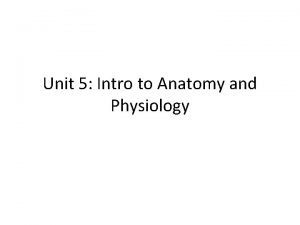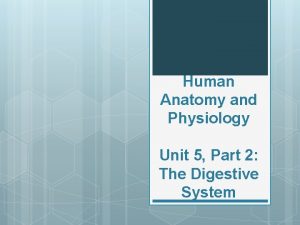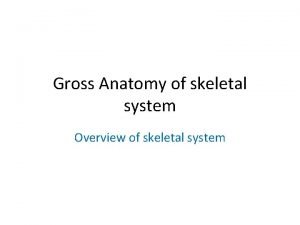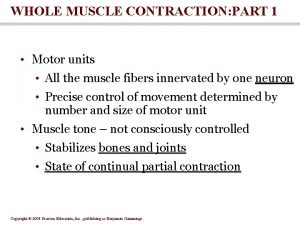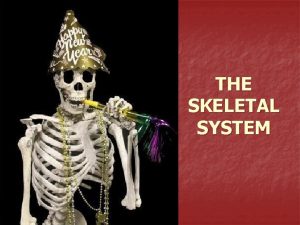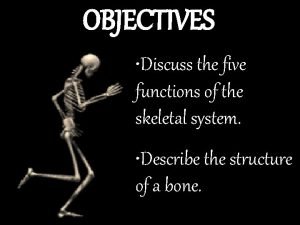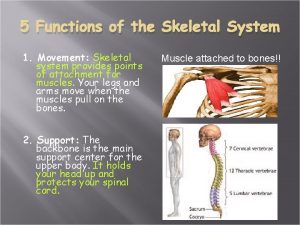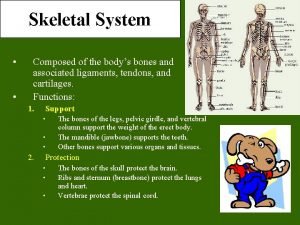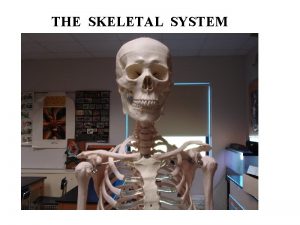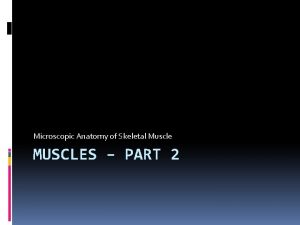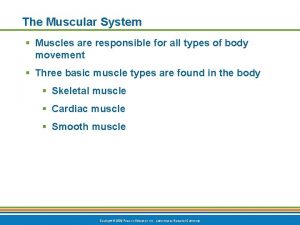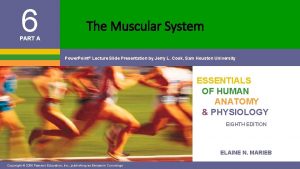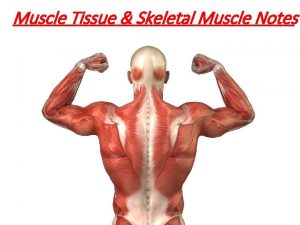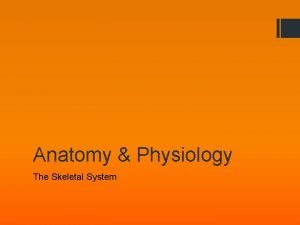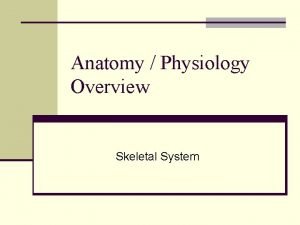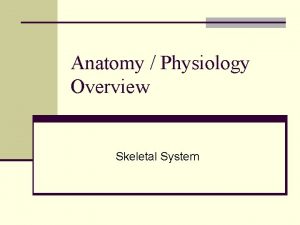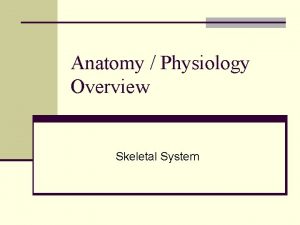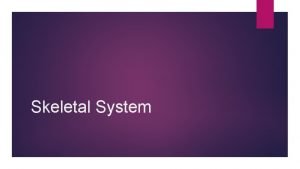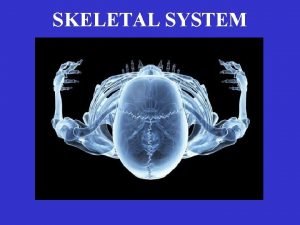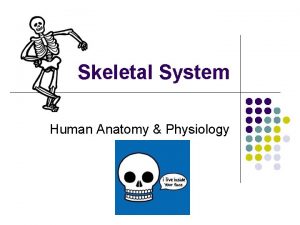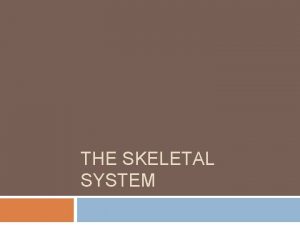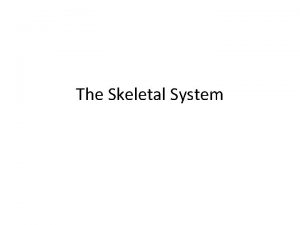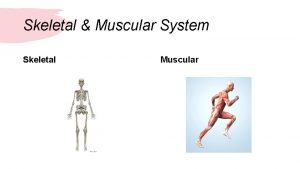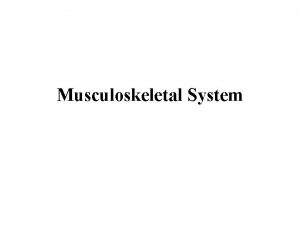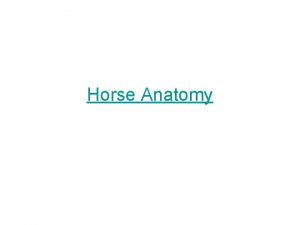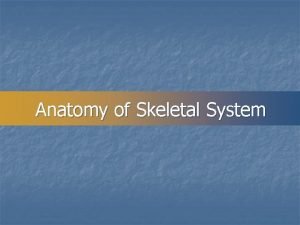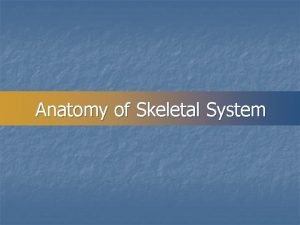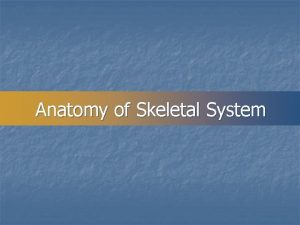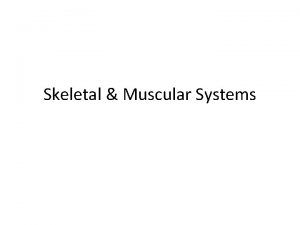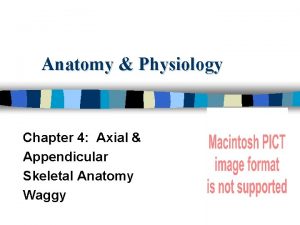ANATOMY PHYSIOLOGY Skeletal System Unit 3 Functions of






























- Slides: 30

ANATOMY & PHYSIOLOGY Skeletal System Unit 3

Functions of bones • Lower extremities support body weight • Support & protect soft body organs • Movement • Storage • Production of RBC’s

Shapes of Bones • Long • Flat – Support weight – Withstand force – Arms & legs • Short – cube-like – Wrist & ankles – thin, flat, curved – Protection – Ribs, sternum & cranium • Irregular – different shapes – Hip, vertebrae

Compact Bone Characteristics • Dense, hard osseous, tightly packed • Shafts of long bones & outer surface of other bones • Haversion system • Blood vessels run lateral

Cancellous Bone Characteristics • Spongy bone • No haversian systems • Trabeculae – Bony plates separated by irregular spaces • Decrease weight of bone • Contain red bone marrow

Functions of Red & Yellow Bone Marrow • Red – Spongy bone – Blood supply for spongy bone – Produces blood cells for body to use • Yellow – Medullary cavity – Storage for fat – In adults, not associated with blood cell production (hematopoiesis)

Parts of Long Bones • Diaphysis – Long shaft – Mostly compact bone – Provides strength • Epiphysis – Enlarged ends – Consists of thin compact bone layer overlying spongy bone – Covered by cartilage – Articulates second bone at a joint

Parts of Long Bones • Epiphyseal disc – Band of hyaline cartilage at ends between epiphysis & diaphysis • Growth plate = longitudinal growth • Medullary cavity – Hollow center of diaphysis • Endosteum – Lining of the inside of the medullary cavity

Parts of Long Bones • Periosteum – Tough fibrous connective tissue covering all outside surfaces of diaphysis except articular cartilage • Protection of the bone • Point of attachment • Contains blood vessels • Articular cartilage – Found on outer surface of epiphysis – Smooth shiny surface decreases friction

Bone Growth & Repair Ossification Flat bones • Osteoblasts – bone forming cells – Migrate to center of thin connective tissue forming flat bone – Secrete calcium & other minerals into spaces between connective tissue = bone Long bones • Osteoblasts invade cartilage, gradually replaced with bone • Articular cartilage & epiphyseal disc not replaced

Growing Bones • Longitudinal growth – Epiphyseal disc • Cartilage next to epiphysis multiplies & grow toward diaphysis • Osteoblasts invade cartilage next to diaphysis which becomes ossified • Bone lengthens as long as cartilage continues to form • Sensitive to hormones – GH = growth – Sex hormones = fuse (seal) discs • Injury to disc = retard bone growth

Growing Bones • Thicker & wider growth – Osteoblasts • Building bone on the outside – Osteoclasts • Breaking down bone tissue on the inside (bone resorption)

Bone Markings Functions • Bone surface irregular & bumpy Know. Table 8 -1 – Projections • Markings that stick out, points of attachment for muscles, tendons & ligaments – Styloid process – tongue, larynx muscles – Mastoid process – neck muscles – Grooves & depressions • Form routes for blood vessels & nerves *Projections & depressions help form joints*

Skeletal Divisions • Axial – – Skull bones Middle ear bones Vertebral column Bony thorax • Appendicular – Extremity bones – Hip bones – Shoulder girdle

Skull Bones • Cranium & facial bones • Cranium = 8 bones – – – Frontal Parietal (2) Temporal (2) Occipital Sphenoid Ethmoid

Cranium Associated Areas • Temporal area bone markings External auditory meatus Zygomatic process Styloid process Mastoid process • Occipital bone Foramen magnum • Sutures Coronal Squamous Lambdoidal

Facial Bones • 14 bones Mandible • Temporomandibular joint Maxillary (2) Palatine (2) Zygomatic (2) Others (nasal, lacrimal, vomer)

Other Associated Areas • Sinuses – Air cavities – 4 paranasal • • Frontal Ethmoidal Sphenoidal Maxillary • Fontanels – “soft spots” • Anterior • Posterior

Vertebral Column Regions • Vertebrae – 26 bones – Cervical (C 1 -C 7) • C 1 – atlas; support • C 2 – axis; pivot – Thoracic (T 1 -T 12) – Lumbar (L 1 -L 5) – Sacrum – Coccyx • Associated areas – Intervertebral disc – Vertebral foramen

Thoracic Cage • Sternum Manubrium Body Xiphoid process • Ribs – True ribs = 1 -7 – False ribs = 8 -10 – Floating = 11 & 12 – Costal cartilage

Shoulder • Pectoral or shoulder girdle – Clavicle – Scapula • Acromion process

Arm • Upper extremities – Humerus – Radius – Ulna

Hand • Hand – Carpals (8) – Metacarpals (5) – Phalanges (14)

Pelvis • Differences: – Female = broader/shallower – Male = narrower / funnel-like • Sacrum • Coccyx Pelvic girdle – 2 coxal (hip) bones joined together Ilium • Iliac crest Ischium • Ischial tuberosity Pubis • Symphysis pubis * Obturator foramen * Acetabulum

Leg • Lower extremity – Femur • Greater & lesser trochanter – Patella – Tibia • Medial malleolus – Fibula • Lateral malleolus

Foot • Foot – Tarsals (7) – Calcaneus – Metatarsals (5) – Phalanges (14)

JOINTS 2 Functions =Hold bones together =Provide flexibility 3 Classification groups =immovable =slightly movable =freely movable (synovial)

Synovial Joints • Structures – Articular cartilage – Joint capsule – Synovial membrane – Synovial fluid – Bursae (bursa) – Supporting ligaments

Synovial Joints Classifications – Hinge – Ball & socket – Pivot – Saddle – Gliding – Condyloid

Movement of Synovial Joints • Flexion • Adduction • Extension • Inversion • Plantar flexion • Eversion • Dorsiflexion • Supination • Hyperextension • Pronation • Abduction • Circumduction
 Male vs female skeleton pelvis
Male vs female skeleton pelvis Anatomy and physiology unit 7 cardiovascular system
Anatomy and physiology unit 7 cardiovascular system Anatomy and physiology chapter 1
Anatomy and physiology chapter 1 Teks anatomy and physiology
Teks anatomy and physiology Unit 26 animal anatomy physiology and nutrition
Unit 26 animal anatomy physiology and nutrition Horizontal anatomical plane
Horizontal anatomical plane Figure 24-12 the stomach
Figure 24-12 the stomach Sally left the party to take cathy home
Sally left the party to take cathy home Respiratory system
Respiratory system Physiology of skeletal muscle
Physiology of skeletal muscle 5 main functions of the skeleton
5 main functions of the skeleton What are the five functions of the skeletal system?
What are the five functions of the skeletal system? Skeletal system 5 main functions
Skeletal system 5 main functions Crash course skull
Crash course skull 5 functions of skeletal system
5 functions of skeletal system Coronal suture
Coronal suture Microscopic anatomy of skeletal muscles
Microscopic anatomy of skeletal muscles Microscopic anatomy of skeletal muscle figure 6-2
Microscopic anatomy of skeletal muscle figure 6-2 Microscopic anatomy of skeletal muscle figure 6-2
Microscopic anatomy of skeletal muscle figure 6-2 Microscopic anatomy of skeletal muscle figure 6-2
Microscopic anatomy of skeletal muscle figure 6-2 Skeletal muscle
Skeletal muscle Parts of the upper respiratory tract
Parts of the upper respiratory tract Tattoo anatomy and physiology
Tattoo anatomy and physiology International anatomy olympiad
International anatomy olympiad Incomplete flower
Incomplete flower Anatomy and physiology of bone
Anatomy and physiology of bone Gastric ulcer
Gastric ulcer Segmental anatomy of the liver
Segmental anatomy of the liver Podbřišek
Podbřišek Epigastric region
Epigastric region Google com
Google com





